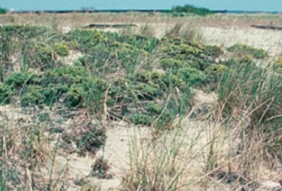
Posted on May 24, 2016
The Christie Administration announced the completion of the third in a series of pilot projects designed to gauge the effectiveness of beneficially reusing silt and sand dredged for navigation improvement projects to restore degraded salt marshes as protective buffers against severe storms, while enhancing habitat for wildlife.
The latest project restored 10 acres of degraded wetlands, and three acres of beach along the Delaware Bay in Fortescue, located in Cumberland County’s Downe Township. The restoration work is part of a pilot study that also involves two wetlands restoration sites along the Atlantic coast in Cape May County.
In the latest project, the Department of Environmental Protection and New Jersey Department of Transportation teamed up to use sediments dredged for maintenance of navigation channels around Fortescue Creek to raise the elevation of 10 acres of degraded wetlands in the state’s Fortescue Wildlife Management Area. The dredged materials were also used to restore a three-acre stretch of beach. Additional marsh and beach restoration will take place in the fall.
“The Christie Administration is committed to making all of New Jersey’s coastal areas more resilient to storms such as Superstorm Sandy,” said DEP Commissioner Bob Martin. “This marsh restoration process holds a great deal of promise to provide many benefits in a cost-effective and environmentally responsible manner. The DEP is committed to working with our state, federal, local, academic and non-profit partners to assess the potential for this process to be applied on a wider scale to help protect our coastal communities from flooding.”
“The NJDOT Office of Maritime Resources has been at the forefront of the dredging industry’s development of beneficial use technology for almost 20 years,” NJDOT Acting Commissioner Richard T. Hammer said. “Being able to place dredged material back onto the marshes rather than disposing of it elsewhere will provide much needed relief to shore communities, recreational boaters and commercial fishermen that depend on New Jersey’s Marine Transportation System, as well as achieve environmental benefits and increased storm protection.”
New Jersey, like other coastal states, is losing salt marshes to a combination of subsidence, erosion and sea level rise. Together, the three projects are testing the effectiveness of a technique known as thin-layer application of dredge materials. In this process, sediments dredged from navigation channels and other areas are pumped onto eroding wetlands to raise their elevations enough to allow native marsh grasses to flourish or to create nesting habitats needed by some rare wildlife species.
Healthy marshes with thick mats of native grasses can cushion the impact of storm surges, thereby reducing property damage. At the same time, the restoration of the wetlands through this process can reduce the need for the creation of confined disposal facilities in coastal areas, which can appear as unnatural-looking plateaus or islands amid vast expanses of marshland.
Located about 15 miles southwest of Millville, the village of Fortescue, the Fortescue State Marina and a private marina have long provided an important hub for fishing in Delaware Bay, serving a robust charter fishing fleet, commercial and private fishing boats, bait-and-tackle shops and related businesses.
“The thin layer application pilot program is an ambitious step in an attempt to restore the meadowlands along the Delaware Bay,” said Downe Township Mayor Robert Campbell. “It is certainly a great solution for the use of dredge material that is usually the biggest roadblock in most dredging projects.
“I thank Commissioner Bob Martin and his municipal liaison, Cindy Randazzo, for their great work toward building a working relationship with the bay communities and supporting many different projects that will aid us in remaining sustainable and resilient,” Mayor Campbell added.
An NJDOT contractor dredged some 15,000 cubic yards of silt and sand from waterways around Fortescue and placed it at the nearby Fortescue Wildlife Management Area, which protects habitat needed by migrating shorebirds such as the federally endangered red knot.
All three of the restoration projects are taking place on Wildlife Management Areas owned by the DEP’s Division of Fish and Wildlife, which manages tens of thousands of acres of marshes along the Atlantic and Delaware Bay coastlines.
In 2014, the DEP and U.S. Army Corps of Engineers restored an acre of wetlands in the Cape May Meadows Wildlife Management Area behind Stone Harbor, using materials dredged from the Intracoastal Waterway. As an additional benefit, the project created nesting habitat for black skimmers, a state-endangered beach-nesting bird.
Based on the initial successes of this small-scale project, the DEP and Army Corps completed a second project last year restoring 35 acres of wetlands in another part of the Cape May Meadows Wildlife Management Area, behind Avalon, using material dredged from the Intracoastal Waterway.
The three projects are made possible by a $3.4 million grant from the U.S. Department of Interior Hurricane Sandy Coastal Resilience Competitive Grant Program. The DEP, working with the Nature Conservancy, Green Trust Alliance and other non-profit partners, is using the funds for biological monitoring and evaluation of the project sites.
Source: Cape May County Herald.com





